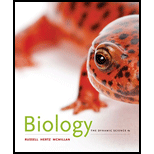
Concept explainers
Which of the following is not an evolutionary trend among plants?
a. developing vascular tissues
b. becoming seedless
c. having a dominant diploid generation
d. producing nonmotile gametes
e. producing two types of spores
Introduction:
Plants are the multicellular eukaryotes that fall under the phylum Plantae. On early Earth, the plants used to live underwater and during the course of evolution, the plants became terrestrial. Plants are the ultimate source of nutrition for all the life forms present on Earth and have evolved in many ways to adapt to the terrestrial life.
Answer to Problem 1TYK
Correct answer:
Becoming seedless is not an evolutionary trend among plants.
Explanation of Solution
Explanation/justification for the correct answer:
Option (b) is becoming seedless. Seedless plants were present on the early Earth because at that time the plants did not have any packaging system to cover and protect their seeds. They were dominant in the late Silurian period, that is about 427 million years ago. When the plants evolved they developed mechanisms to protect their embryo inside a seed covering. Hence, option (b) is correct.
Explanation for the incorrect answers:
Option (a) is developing vascular tissues. The plants that were present on the early Earth belonged to the clade bryophytes, which did not have any elaborate vascular systems. With the evolution of the plants, they developed a vascular system in order to transport the sugars and water synthesized during photosynthesis. So, it is an incorrect option.
Option (c) is having a dominant diploid generation. In early plants, that lived underwater, the life of haploid gametophyte was long. When the plants adapted to terrestrial life, the life of the diploid sporophyte became longer as compared to the haploid gametophyte. So, it is an incorrect option.
Option (d) is producing non-motile gametes. Due to the absence of water on land, the plants found other methods to transport their gametes, without the help of water. Some plants have very beautiful flowers that attract bees, birds, and other animals, which help in the dispersal of seeds and in return they get nectar and other rewards. Some plants have very light pollens, which are transferred with the help of wind. So, it is an incorrect option.
Option (e) is producing two types of spores. The vascular plants developed as a result of evolution. They have two types of spores that are male and female spores. These plants are called heterosporous. The male gametes are called pollens and the female gametes are called eggs. So, it is an incorrect option.
Hence, options (a), (c), (d), and (e) are incorrect
Thus, it can be concluded that as plants evolved, they developed a mechanism to protect their embryo in the form of seeds, became vascular and heterosporous. The plants also developed non-motile gametes and dominant diploid sporophyte.
Want to see more full solutions like this?
Chapter 28 Solutions
Biology: The Dynamic Science (MindTap Course List)
- What is the structure and function of Eukaryotic cells, including their organelles? How are Eukaryotic cells different than Prokaryotic cells, in terms of evolution which form of the cell might have came first? How do Eukaryotic cells become malignant (cancerous)?arrow_forwardWhat are the roles of DNA and proteins inside of the cell? What are the building blocks or molecular components of the DNA and proteins? How are proteins produced within the cell? What connection is there between DNA, proteins, and the cell cycle? What is the relationship between DNA, proteins, and Cancer?arrow_forwardWhy cells go through various types of cell division and how eukaryotic cells control cell growth through the cell cycle control system?arrow_forward
- In one paragraph show how atoms and they're structure are related to the structure of dna and proteins. Talk about what atoms are. what they're made of, why chemical bonding is important to DNA?arrow_forwardWhat are the structure and properties of atoms and chemical bonds (especially how they relate to DNA and proteins).arrow_forwardThe Sentinel Cell: Nature’s Answer to Cancer?arrow_forward
- Molecular Biology Question You are working to characterize a novel protein in mice. Analysis shows that high levels of the primary transcript that codes for this protein are found in tissue from the brain, muscle, liver, and pancreas. However, an antibody that recognizes the C-terminal portion of the protein indicates that the protein is present in brain, muscle, and liver, but not in the pancreas. What is the most likely explanation for this result?arrow_forwardMolecular Biology Explain/discuss how “slow stop” and “quick/fast stop” mutants wereused to identify different protein involved in DNA replication in E. coli.arrow_forwardMolecular Biology Question A gene that codes for a protein was removed from a eukaryotic cell and inserted into a prokaryotic cell. Although the gene was successfully transcribed and translated, it produced a different protein than it produced in the eukaryotic cell. What is the most likely explanation?arrow_forward
 Biology (MindTap Course List)BiologyISBN:9781337392938Author:Eldra Solomon, Charles Martin, Diana W. Martin, Linda R. BergPublisher:Cengage Learning
Biology (MindTap Course List)BiologyISBN:9781337392938Author:Eldra Solomon, Charles Martin, Diana W. Martin, Linda R. BergPublisher:Cengage Learning
 Biology: The Dynamic Science (MindTap Course List)BiologyISBN:9781305389892Author:Peter J. Russell, Paul E. Hertz, Beverly McMillanPublisher:Cengage Learning
Biology: The Dynamic Science (MindTap Course List)BiologyISBN:9781305389892Author:Peter J. Russell, Paul E. Hertz, Beverly McMillanPublisher:Cengage Learning Concepts of BiologyBiologyISBN:9781938168116Author:Samantha Fowler, Rebecca Roush, James WisePublisher:OpenStax College
Concepts of BiologyBiologyISBN:9781938168116Author:Samantha Fowler, Rebecca Roush, James WisePublisher:OpenStax College Biology Today and Tomorrow without Physiology (Mi...BiologyISBN:9781305117396Author:Cecie Starr, Christine Evers, Lisa StarrPublisher:Cengage Learning
Biology Today and Tomorrow without Physiology (Mi...BiologyISBN:9781305117396Author:Cecie Starr, Christine Evers, Lisa StarrPublisher:Cengage Learning





